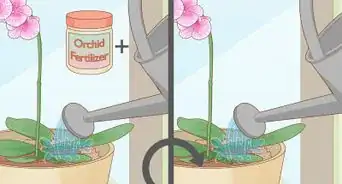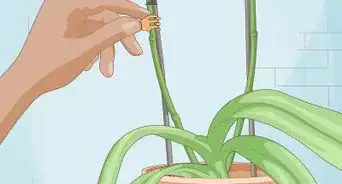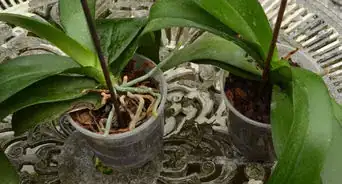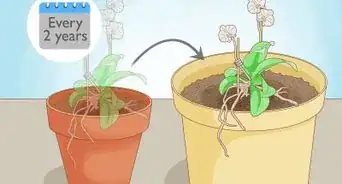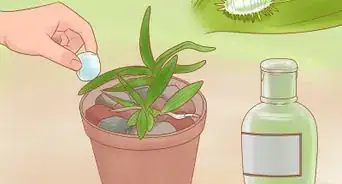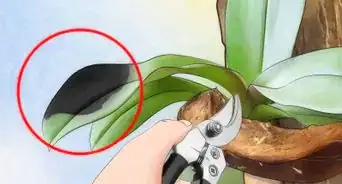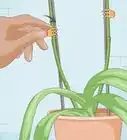This article was co-authored by Harmony Corelitz and by wikiHow staff writer, Madeleine Criglow. Harmony Corelitz is a Plant Specialist and the Ecommerce Manager at Crimson Horticultural Rarities, Inc, a boutiue offering rare plants, flower arragements, and handmade goods. Harmony grew up helping her parents run their family business in plant maintenance and interior plantscaping. Harmony specializes in indoor plant care and interior plant design. Prior to her workwith Crimson Horticultural Rarities, she started her pop-up plant and vintage home goods shop called Younger Child and helped her former employer, Plants and Friends, grow and expand to two locations. She holds a BA from the University of San Francisco.
wikiHow marks an article as reader-approved once it receives enough positive feedback. This article received 32 testimonials and 96% of readers who voted found it helpful, earning it our reader-approved status.
This article has been viewed 525,009 times.
Moth orchids are a beautiful means to liven up a space. As one of the most popular houseplants, moth orchids are also pretty easy to take care of once you get the hang of them. You just need to make sure they’re getting the right balance of light, water, and nutrients.
Here are 8 tips for caring for a moth orchid so it thrives.
Steps
Expert Q&A
-
QuestionHow do you repot an orchid?
 Harmony CorelitzHarmony Corelitz is a Plant Specialist and the Ecommerce Manager at Crimson Horticultural Rarities, Inc, a boutiue offering rare plants, flower arragements, and handmade goods. Harmony grew up helping her parents run their family business in plant maintenance and interior plantscaping. Harmony specializes in indoor plant care and interior plant design. Prior to her workwith Crimson Horticultural Rarities, she started her pop-up plant and vintage home goods shop called Younger Child and helped her former employer, Plants and Friends, grow and expand to two locations. She holds a BA from the University of San Francisco.
Harmony CorelitzHarmony Corelitz is a Plant Specialist and the Ecommerce Manager at Crimson Horticultural Rarities, Inc, a boutiue offering rare plants, flower arragements, and handmade goods. Harmony grew up helping her parents run their family business in plant maintenance and interior plantscaping. Harmony specializes in indoor plant care and interior plant design. Prior to her workwith Crimson Horticultural Rarities, she started her pop-up plant and vintage home goods shop called Younger Child and helped her former employer, Plants and Friends, grow and expand to two locations. She holds a BA from the University of San Francisco.
Plant Specialist For an orchid, you're going to need to take care to see what type of soil substrate it needs. Orchids aren't typically grown in actual soil. They're going to be grown in Spagna moss, or a mix of bark. They can be potted in orchid bark as well. You're going to want a pot that has lots of aeration. Orchids are epiphytic, so their roots need a lot of aeration and drainage. You're never going to want to pot an orchid into a pot that is much bigger than its existing grow pot. They like to stay very compact in the soil since their structure is really held together by the roots. I would suggest choosing a pot that's only 1-2 inches wider in diameter.
For an orchid, you're going to need to take care to see what type of soil substrate it needs. Orchids aren't typically grown in actual soil. They're going to be grown in Spagna moss, or a mix of bark. They can be potted in orchid bark as well. You're going to want a pot that has lots of aeration. Orchids are epiphytic, so their roots need a lot of aeration and drainage. You're never going to want to pot an orchid into a pot that is much bigger than its existing grow pot. They like to stay very compact in the soil since their structure is really held together by the roots. I would suggest choosing a pot that's only 1-2 inches wider in diameter. -
QuestionHow do I know if my orchid needs to be repotted?
 Harmony CorelitzHarmony Corelitz is a Plant Specialist and the Ecommerce Manager at Crimson Horticultural Rarities, Inc, a boutiue offering rare plants, flower arragements, and handmade goods. Harmony grew up helping her parents run their family business in plant maintenance and interior plantscaping. Harmony specializes in indoor plant care and interior plant design. Prior to her workwith Crimson Horticultural Rarities, she started her pop-up plant and vintage home goods shop called Younger Child and helped her former employer, Plants and Friends, grow and expand to two locations. She holds a BA from the University of San Francisco.
Harmony CorelitzHarmony Corelitz is a Plant Specialist and the Ecommerce Manager at Crimson Horticultural Rarities, Inc, a boutiue offering rare plants, flower arragements, and handmade goods. Harmony grew up helping her parents run their family business in plant maintenance and interior plantscaping. Harmony specializes in indoor plant care and interior plant design. Prior to her workwith Crimson Horticultural Rarities, she started her pop-up plant and vintage home goods shop called Younger Child and helped her former employer, Plants and Friends, grow and expand to two locations. She holds a BA from the University of San Francisco.
Plant Specialist In general, you should repot your orchid once a year. You might need to repot it sooner if the roots have completely overgrown the pot it is in or if it starts to lose some lower leaves.
In general, you should repot your orchid once a year. You might need to repot it sooner if the roots have completely overgrown the pot it is in or if it starts to lose some lower leaves. -
QuestionWhat sort of flower pots should they be used?
 Community AnswerTransparent pots are best for phals so you can see if there's a need for water by actually seeing the roots.
Community AnswerTransparent pots are best for phals so you can see if there's a need for water by actually seeing the roots.
References
- ↑ https://www.missouribotanicalgarden.org/gardens-gardening/your-garden/help-for-the-home-gardener/advice-tips-resources/visual-guides/repotting-phalaenopsis-and-other-monopodial-orchid.aspx
- ↑ https://www.missouribotanicalgarden.org/Portals/0/Gardening/Gardening%20Help/Factsheets/Orchid%20Problems34.pdf
- ↑ https://www.missouribotanicalgarden.org/Portals/0/Gardening/Gardening%20Help/Factsheets/Orchid%20Problems34.pdf
- ↑ https://youtu.be/3wVKQ6C3CUM?t=57
- ↑ https://www.rhs.org.uk/advice/profile?pid=388
- ↑ https://youtu.be/3wVKQ6C3CUM?t=57
- ↑ https://www.missouribotanicalgarden.org/Portals/0/Gardening/Gardening%20Help/Factsheets/Orchid%20Problems34.pdf
- ↑ https://www.plantindex.com/phalaenopsis-orchid-light-requirements/
- ↑ https://www.rhs.org.uk/advice/profile?pid=388
- ↑ https://www.rhs.org.uk/advice/profile?pid=388
- ↑ https://www.rhs.org.uk/advice/profile?pid=388
- ↑ https://www.rhs.org.uk/advice/profile?pid=388
- ↑ https://www.rhs.org.uk/advice/profile?pid=388
- ↑ https://www.rhs.org.uk/advice/profile?pid=388
- ↑ https://www.missouribotanicalgarden.org/gardens-gardening/your-garden/help-for-the-home-gardener/advice-tips-resources/visual-guides/repotting-phalaenopsis-and-other-monopodial-orchid.aspx
- ↑ https://www.missouribotanicalgarden.org/gardens-gardening/your-garden/help-for-the-home-gardener/advice-tips-resources/visual-guides/repotting-phalaenopsis-and-other-monopodial-orchid.aspx
- ↑ https://www.missouribotanicalgarden.org/Portals/0/Gardening/Gardening%20Help/Factsheets/Orchid%20Problems34.pdf
- ↑ https://www.missouribotanicalgarden.org/Portals/0/Gardening/Gardening%20Help/Factsheets/Orchid%20Problems34.pdf
About This Article
For the healthiest phals orchid possible, make sure your orchid is in a plastic or clay pot filled with bark mix. Set your phals in an area where it has access to indirect or filtered sunlight, and keep it at a temperature of around 70 °F. Water your phals weekly, and supplement the bark mix with a 10/10/10 or 20/20/20 food formula diluted in water every month.
-Step-1-Version-2.webp)
-Step-2-Version-2.webp)
-Step-3-Version-2.webp)
-Step-4-Version-2.webp)
-Step-5-Version-2.webp)
-Step-6-Version-2.webp)
-Step-7.webp)
-Step-8.webp)

